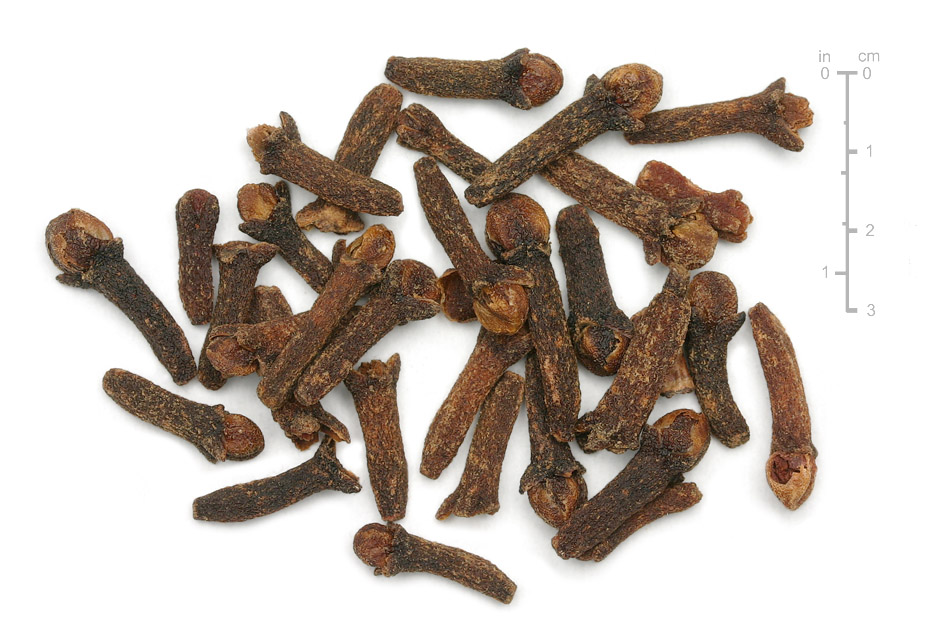|
Syzygium aromaticum
Common Names: Clove, Clove Tree, Laung
Local Names: Cengkeh (Indonesia), Lavang (Hindi, India), Kirambu
(Tamil) Kananfari (Hausa, Nigeria), Dingxiang (Mandarin, China)
Species ID: NMP-061 | wfo-0000956403 | NCBI_Taxonomy ID: 219868
Scientific
Classification
Kingdom: Plantae
Clade: Tracheophytes
Clade: Angiosperms
Clade: Eudicots
Clade: Rosids
Order: Myrtales
Family: Myrtaceae
Genus: Syzygium
Species: S. aromaticum
Binomial Name: Syzygium aromaticum (L.) Merr. & L.M.Perry
Synonyms: Caryophyllus aromaticus L., Eugenia aromatica (L.) Baill., Eugenia caryophyllata Thunb., Eugenia caryophyllus (Spreng.) Bullock &
S.G.Harrison, Jambosa caryophyllus (Thunb.) Nied.
Morphological
Description
Syzygium aromaticum is an evergreen tree growing 8–20 m tall,
with a conical shape. Key features include:
- Bark: Smooth, grayish, becoming rough with age
- Leaves: Glossy, ovate-elliptic, 8–13 cm long, aromatic
- Flowers: Crimson, in terminal clusters; buds pale, turning
green then red
- Fruit: Dark purple drupes, 2–2.5 cm long, rarely formed
Cloves, the dried flower buds, are nail-shaped, 1.5–2 cm long,
harvested before blooming (Cortés-Rojas et al., 2014).
Syzygium aromaticum thrives in:
- Native Range: Moluccas (Maluku Islands), Indonesia
- Cultivated Range: Tanzania (Zanzibar), Madagascar, India, Sri Lanka
- Habitat: Tropical coastal areas, 0–200 m altitude
- Soil/Climate: Well-drained, loamy soils; warm, humid,
1,500–2,500 mm rainfall
It’s a major global spice, with Tanzania producing 80% of supply
(Batiha et al., 2020).
Syzygium aromaticum, commonly known as clove, has been
traditionally utilized in various medicinal practices. Its applications include
aiding digestion, relieving respiratory ailments, and serving as an antiseptic.
The therapeutic properties of clove are largely attributed to its bioactive
compounds, such as eugenol, which exhibit antimicrobial, antioxidant,
anti-inflammatory, antifungal, and analgesic effects. Common preparations
include digestive teas, respiratory tinctures, topical infusions, pain-relieving
salves, and clove oil. However, improper use can lead to side effects like
interactions with medications, headaches, dizziness, liver damage, and allergic
reactions. Cloves have been used traditionally across cultures, with studies
validating their benefits:
- Analgesic: Ayurvedic toothache remedy; eugenol reduces pain
in rats (50% at 50 mg/kg) (Daniel et al., 2009).
- Antimicrobial: Chinese use for infections; inhibits S. aureus (MIC 0.31 mg/mL) (Chaieb et al., 2007).
- Digestive Aid: Unani remedy for bloating; stimulates gastric
mucus in rats (Agbaje, 2008).
- Anti-inflammatory: European use for sore throat; reduces edema (40%
at 100 mg/kg) (Ozturk & Ozbek, 2005).
- Antioxidant: Indonesian preservation; scavenges DPPH (IC₅₀
0.03 mg/mL) (Gülçin et al., 2011).
Key compounds include:
- Eugenol: 70–95%, analgesic, antimicrobial (Kamatou et al.,
2012).
- Eugenyl Acetate: 5–15%, antifungal (Batiha et al., 2020).
- β-Caryophyllene: 5–12%, anti-inflammatory (Chaieb et al., 2007).
- Gallic Acid: Antioxidant, phenolic (Cortés-Rojas et al.,
2014).
⚠ Toxicity Profile: Eugenol safe up to 2.5 mg/kg; overdose (>5 mL
oil) causes liver damage, convulsions (LD₅₀ 2,650 mg/kg in rats) (Hartnoll et
al., 1993).
- Historical Significance: Drove spice trade, valued in ancient Rome
(Kamatou et al., 2012).
- Clove Oil: Used in dentistry, perfumes, insect repellents
(Batiha et al., 2020).
- Culinary Use: Spices meats, desserts; enhances flavor in Asia,
Africa (Cortés-Rojas et al., 2014).
- Ecological Role: Supports pollinators like bees in plantations
(PROTA, 2019).
- Agbaje, E. O. (2008). Gastrointestinal effects of Syzygium aromaticum in animal models. African Journal of
Traditional, Complementary and Alternative Medicines, 5(2), 165–170. DOI: 10.4314/nqjhm.v18i3.45015
- Batiha, G. E.-S., Alkazmi, L. M., Wasef, L. G., Beshbishy, A. M.,
Nadwa, E. H., & Rashwan, E. K. (2020). Syzygium aromaticum L. (Myrtaceae): Traditional uses,
bioactive chemical constituents, pharmacological and toxicological
activities. Biomolecules, 10(2), 202. https://doi.org/10.3390/biom10020202
- Chaieb, K., Hajlaoui, H., Zmantar, T., Kahla-Nakbi, A. B.,
Rouabhia, M., Mahdouani, K., & Bakhrouf, A. (2007). The chemical
composition and biological activity of clove essential oil, Eugenia caryophyllata (Syzygium aromaticum L. Myrtaceae): A short review. Phytotherapy Research,
21(6), 501–506.
https://doi.org/10.1002/ptr.2124
- Cortes-Rojas, D. F., de Souza, C. R. F., & Oliveira, W. P.
(2014). Clove (Syzygium aromaticum): A precious spice. Asian Pacific Journal of Tropical Biomedicine, 4(2), 90–96.
https://doi.org/10.1016/S2221-1691(14)60215-X
- Daniel, A. N., Sartoretto, S. M., Schmidt, G., Caparroz-Assef, S.
M., Bersani-Amado, C. A., & Cuman, R. K. N. (2009). Anti-inflammatory and
antinociceptive activities of eugenol essential oil in experimental animal
models. Revista Brasileira de Farmacognosia, 19(1B), 212–217.
- Gulçin, İ. (2011). Antioxidant activity of eugenol: A
structure-activity relationship study. Journal of Medicinal
Food, 14(9), 975–985.
https://doi.org/10.1089/jmf.2010.0197
- Hartnoll, G., Moore, D., & Douek, D. (1993). Near fatal
ingestion of clove oil in a child. Journal of Accident & Emergency Medicine, 10(3), 151–152.
- Kamatou, G. P., Vermaak, I., & Viljoen, A. M. (2012).
Eugenol—From the remote Maluku Islands to the international market place: A
review of a remarkable and versatile molecule. Molecules, 17(6), 6953–6981.
https://doi.org/10.3390/molecules17066953
- Ozturk, A., & Ozbek, H. (2005). The anti-inflammatory activity
of Eugenia caryophyllata essential oil: An animal model of anti-inflammatory
activity. European Journal of General Medicine, 2(4), 159–163.
- PROTA. (2019). Syzygium aromaticum. Plant Resources of Tropical Africa. Retrieved
from https://uses.plantnet-project.org/en/Syzygium_aromaticum_(PROTA)
 |
